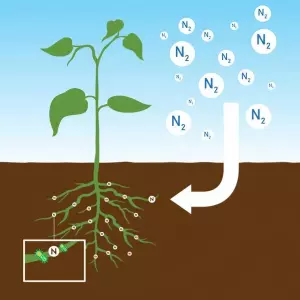
Legumes are plant species with a distinctive fruit called a pod. They are grown all over the world and include soya, beans, peas, broad beans, lentils, and haricot beans. They are also widely used for intercropping, between two main crops. Selected species are field bean, pea, vetch, grass pea, etc. They have a particular capacity that makes them one of the most popular species for intercropping: they capture atmospheric nitrogen. The advantages of cover crops.
How does a legume-based cover crop fix atmospheric nitrogen?
Plants need essential nutrients to grow, including nitrogen. Nitrogen is involved in the production of proteins and enzymes. It is also an essential component of nucleic acids, DNA, and chlorophyll. It plays an important role in photosynthesis and in the development of plant matter. Nitrogen is generally taken up by plant roots in the form of nitrate NO3- or ammonium NH4+ ions, which are soluble in the soil.
Only legumes are capable of fixing N2 atmospheric nitrogen. This form is the main constituent of air (78%), so the source is inexhaustible. N2 fixation results from symbiosis with nitrogen-fixing bacteria. These bacteria are found in the roots of leguminous plants, in organs called nodules. Nodules are modifications of the absorbent hairs developed by plant-bacteria interaction to improve their nitrogen supply.

Why sow legumes as intermediate crops?
Planting legumes as intermediate crops is beneficial in different ways. Once the nitrogen has been fixed by the bacteria, 75% of it is transformed and sent to the parts of the plant above ground. When a cover crop is destroyed and left on the field, the organic matter in the residues is mineralised and the nitrogen released for the next crop. Yield can increase by 3 to 27 quintals per hectare with wheat, compared to other cover crops. Nitrogen release depends on the species, with certain legumes being more efficient. The development of the cover crop’s biomass is also a determining factor in the quantity of nitrogen released. Nitrogen release lessens the need for external mineral fertilisers, lowering costs for farmers.
Legumes can be sown alone or mixed for intercropping
Leguminous cover crops are technically feasible but not always in line with regulations. In fact, they are less effective than grasses or crucifers when it comes to nitrate-fixing, as they fix nitrogen from the air rather than the soil, whereas the aim of intercropping is to avoid this. Before choosing a legume as a cover crop, you need to find out about local regulations.
Alternatively, you can opt for mixtures with lower proportions of legumes. Often, species are chosen from two families: legumes + grasses or legumes + crucifers, but mixtures of 3 to 5 species can be used too. Experiments have shown that they increase biomass.
